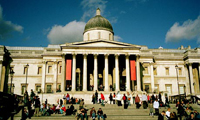 Gallery giants reach uneasy truce over great 1900 divide
Gallery giants reach uneasy truce over great 1900 divide• Tate and National Gallery end four-year impasse
• Deal made before Picasso show at 'wrong' venue
* Charlotte Higgins, chief arts writer
* The Guardian, Friday 20 February 2009
* Article history
The National Gallery in London. Photograph: Eamonn McCabe/Guardian
The two titans of the British art world, the National Gallery and the Tate, have finally edged towards a truce after four years of disagreement about where the cut-off between their collections should be.
The armistice comes just days before the opening of the National Gallery's latest blockbuster, devoted to Picasso - an artist whose natural territory is, arguably, Tate Modern rather the National Gallery.
A 1996 agreement, stating that the dividing line between the collections should be at 1900, lapsed in 2007 and has only just been reaffirmed, despite discussions within and between the galleries since at least late 2005.
Broadly, Tate Modern covers international art from 1900, the National Gallery houses international art to 1900, and Tate Britain is the custodian of British art from 1500 to the present day.
But the National Gallery has been challenging this strict boundary in recent years. Last March, its then new director, Nicholas Penny, noted publicly that "the National Gallery was built to house contemporary art". In September, he was quoted as saying: "The idea is not to have an agreement. We are not happy with 1900 as a final, absolute point of the end of the National Gallery."
Even before Penny was appointed, the National Gallery is understood to have been unhappy with 1900 as the endpoint of its collections.
In practice it has been developing its involvement with modern and contemporary art, with a high-profile artist-in-residence scheme. In November, it will temporarily install Hoerengracht (1984-88), by Ed and Nancy Kienholz, a walk-in installation that recreates the "whores' canal" of Amsterdam's red light district. It is intended to cast light on the gallery's 17th-century Dutch paintings, many of which show scenes from the demimonde.
The cut-off has practical implications, with the galleries exchanging works that sit on the "wrong" side of the line on long-term loan. Fifty works belonging to the Tate are in the National Gallery, while only three works belonging to the National Gallery are in the Tate (a Matisse, a Monet and a Picasso, the last now back in the National Gallery for the Picasso exhibition).
A minute from a 2005 Tate trustee meeting records Nicholas Serota, the director of Tate, as noting "the agreement [is] not in Tate's favour in the short term because it [means] that 50 paintings were loaned to the National Gallery".
The original agreement was signed as the decision to create Tate Modern was made. A statement dating from 1996 stated: "The decision to create [Tate Modern] has provided a fresh opportunity to reassess the distribution of works between the ... galleries. Major artists whose work straddles the turn of the century will continue to be shown to their best advantage across the whole range of their career where possible by the respective galleries."
A Tate trustees' report of November 2005 also explained that the agreement was made, "because the national collection of European painting covering the period 1875 to 1910 was divided between the two institutions in a way that left neither with a very satisfactory representation".
The latest agreement was not made available to the Guardian, and Penny and Serota declined to comment. However, it is understood that it affirms the same principles as those laid out in 1996. There are provisos to the "1900 rule": the Tate recognises that the National Gallery may wish to acquire 20th-century works by artists usually associated with the 19th (eg Cézanne, Monet and Renoir) - and vice versa. The institutions need not confine exhibitions to the period of their collections. Both agree not to seek bequests outside their basic timeframes.
The National Gallery and the Tate have had cause to work together in the recent past on one of the most important artistic bequests ever made to the nation - the £100m Sainsbury bequest of 18 works left to both institutions in 2007. The paintings were shown at Tate Britain last year before being distributed between the galleries.
 Gallery giants reach uneasy truce over great 1900 divide
Gallery giants reach uneasy truce over great 1900 divide